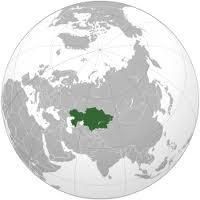ALMATY (TCA) — The year 2015 is bound to stay on people’s memories in Kazakhstan as the year everybody expected the curtain to fall – on people’s heads, that is. The current year, with the country’s national currency held by the fortunes of a ghost that keeps refusing to return into its bottle, unless cash flows are restored to durable levels. To allow this to happen, the government has resorted to what remarkably looks like Russia’s notorious stock-for-loans scheme worked out by the tandem Gaidar/Chubais in the mid-1990s. Will it work out this time?
There are many Kazakh enterprises now wholly or in part controlled by the state that in the course of this year are “planned to be transferred to the competitive environment”, which means to be privatized. Between the many enterprises we list many airports such as the Astana international airport and the Korkyt Ata International Airport in Kyzylorda, Pavlodar Airport, Aktobe International Airport, Atyrau International Airport, Aktau international sea trade port, and Kazakhstan’s 51 percent share in the national flag-carrier Air Astana. Among large companies related to the infrastructural sector we list Kazakhtelecom, power- and power-related companies and the national railway grid and affiliated enterprises. Among KazMunayGas’s subsidiaries, KMG International N.V., which owns the assets in Romania, the Atyrau refinery, Pavlodar Petrochemical Plant, PetroKazakhstan Oil Products (Shymkent refinery), Kazmortransflot National Maritime Shipping Company, and others. But the core of Kazakhstan’s economy, namely KMG itself, will be spared. In other words: both foreign and domestic investors will keep playing second violin.
Cut spending, sell assets
Global oil and gas investments are expected to fall to their lowest in six years in 2016 to $522 billion, following a 22 percent fall to $595 billion in 2015, according to the Oslo-based consultancy Rystad Energy.
International oil companies are once again being forced to cut spending, sell assets, shed jobs and delay projects as the oil slump shows no sign of recovery. US producers Chevron and ConocoPhillips both of which have substantial stakes in Kazakhstan’s upstream sector have published plans to slash their 2016 budgets by a quarter. Royal Dutch Shell has also announced a further $5 billion in spending cuts if its planned takeover of BG Group goes ahead. Both of them have stakes in Kazakhstan’s upstream sector as well. In the case of Chevron/Exxon and Shell/BG there is the risk of a combined bid to sell all assets held on Kazakh territory on the open market. The Kazakh state has the right of first bid, but will have to pass it due to lack of funds. As for the pending offshore project of Kashagan, should more international investors decide to pull back due to high production costs and low sales value remains to be seen.
Market positions at risk
2015 will be mostly remembered for its “monetary revolution” in Kazakhstan. In August last year, the Kazakh National Bank stopped intervening on the ForEx, following a number of overnight devaluations which had the opposite effect of the one meant to achieve. Ever since, the Kazakh tenge continued to slide due to citizens’ efforts to protect their money’s value. On January 8, 2016, Kazakhstan’s currency hit a record low of 351.85 tenge to the U.S. dollar at the Kazakhstan Stock Exchange.
For the average common Kazakh citizen, the situation has led to one in which one keeps small change to go to the shop on the corner and to pay public services bills in local currency while keeping even modest cash reserves mainly in dollars and euros, and to lesser extents in Russian roubles and Chinese yuans due to both countries’ extreme caution to fully join the global monetary arena. Both China and Russia know that by doing so, prices for commodity and half-fabricates would soar as expressed in their own currencies and this puts Russia’s (and Kazakhstan’s) market positions at risk.
A currency market jungle
The main reason for Kazakhstan’s monetary deadlock is that one can do little with large amounts of tenge in the current economic situation. Banks either bluntly refuse to issue credits in the national currency or put interest rates at forbidding levels. This is isolating banks and holding their tail in the real estate and other capital goods markets from the general public. Even state-granted soft loan offers are nowadays looked upon with suspicion, since the unpredictable near future of cash value puts both lenders and borrowers at risk.
For 2016, various scenarios can be imagined. First, the government could put a fence around the national currency by banning deposits in foreign currencies and obliging receivers of cross-border transactions to convert the received cash into tenge on arrival. Second, the National Bank could peg the tenge to a closely related foreign currency, most probably the Russian rouble. Third, a laissez-faire policy could be pursued, leading to a currency market jungle of which the greenback is all but undisputed lord.
* Editor’s note: This is the fifth, and last, part of a TCA series of articles reviewing Central Asia’s results in 2015 and outlooks for 2016, written by our analyst Charles van der Leeuw.
The previous articles:
Turkmenistan in 2015 and into 2016: hopes and headaches
Uzbekistan in 2015 and into 2016: hopes and headaches



